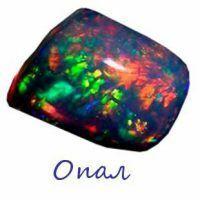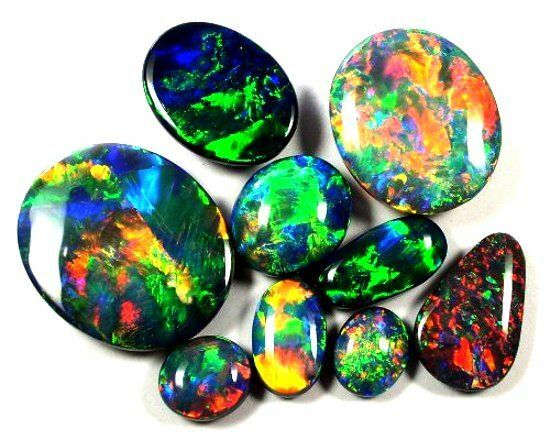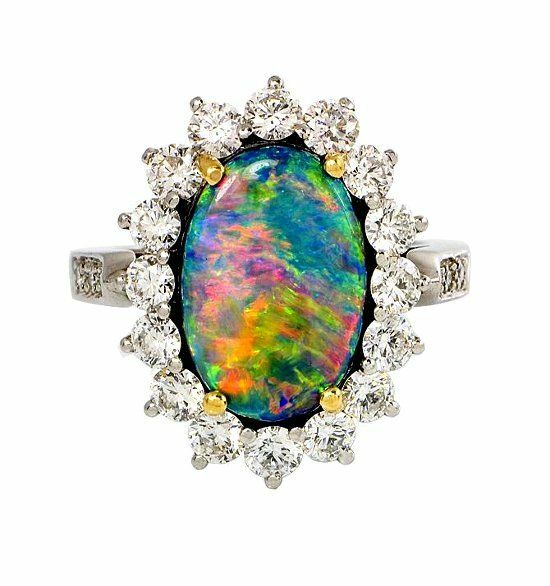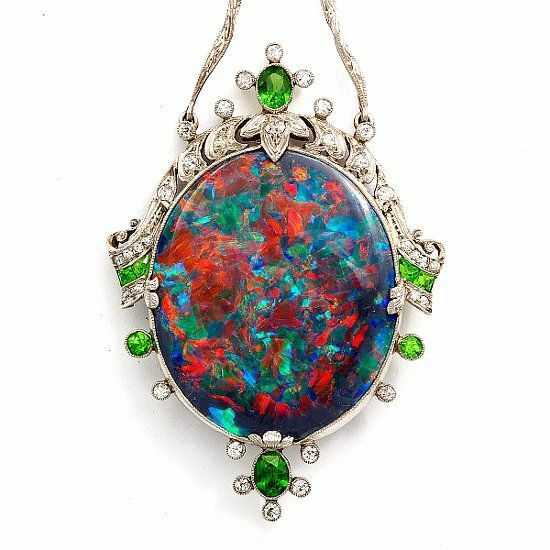
Stone opal for its unique properties and, above all, a unique coloring, called the teardrop of the gods. This beautiful stone has been known since antiquity and to this day, centuries later, thanks to its magical properties, it simultaneously inspires and inspires fear.
- history stone
- mineral Description
- Varieties of opal
- chemical composition and physical properties of the stone
- deposits of opal
- Medicinal properties of mineral
- magical properties of opal
- Opal zodiac
- Application Gem
- Interesting facts about
- stone How to distinguish natural opal counterfeiting
- Stone Care
- Photos of stone opal and its products
History of the stone
The dawn of the popularity of opal fell on the ancient times. Then in Ancient Rome jewelry with this precious gem could afford only high-ranking people. One day, because of the opal ring, Mark Antony stripped Senator Nonia of his post, when he did not want to give the decoration that belonged to him with opal.
Later, in the Middle Ages, opal became the center of all sorts of superstitions. In those days, he was a mascot of thieves, since it was believed that he was able to make a person invisible, and was also a stone of black magicians and alchemists - he was used as a component for the manufacture of all sorts of poisons. And only in the XV-XVI century opal justified its good name and again came into fashion. But, unfortunately, not for long.
In 1829, the famous writer Walter Scott described in his novel "Anna of Gaierstein" the mystical power of opal, which brought the family of the heroine some misfortunes and misfortunes. Because of the superstition of buyers, the best jewelry houses turned out to be on the verge of bankruptcy. Thus, Walter Scott for several years virtually destroyed the European market of opals.
Finally opal was justified only in the XIX century due to the British Queen Victoria. In addition to the fact that the Queen wore amazing opal decorations at every opportunity, she also presented these exquisite gems as gifts.
Today the best opal collections decorate the exhibition of the Australian Museum, the Smithsonian Institution and the Museum of Natural History in Vienna.
to contents ^Description of mineral
Opal is called a mysterious and unique stone. And all thanks to its unique, inimitable coloring, which has no analogues on the planet.
The main distinguishing feature of opal is opalescence - a unique play of light. Unique microscopic inclusions inside the stone create this effect, thanks to which opal shines with beautiful milk and pearl gleams.
Describe the color of this gem is quite difficult, becauseit shimmers with all sorts of shades, including bright fire, colorful black, mysterious green and gentle blue.
Thanks to such amazing coloring, the stone deservedly acquired the status of an especially valuable gem among other jewels.
Its name exactly corresponds to the description of the mineral, after all, opal got it from the Latin word "opalus"( change of colors), the Greek word "opalios"( changing color), Sanskrit "upala"( gemstone).
to contents ^Opal varieties
Opal has an impressive number of varieties. In total there are more than 140 kinds of opals in the world.
Depending on the color, transparency, gloss and hardness, its following groups are distinguished:
- Half-fired. This mineral has a muddy color and has a fat gloss. In nature there is gray, white, red, brown and yellow flowers. It is formed from silica.
- Opal jasper. In its chemical composition, this mineral has an impressive admixture of iron oxides. Often, the stone has a brown or red color.
- Wooden opal. In its composition has impurities of wood residues. The stone has a beautiful textural pattern of wood.
- Siliceous tuff. This mineral has a porous structure. As a rule, it is formed from hot springs.
- Noble opal. A kind of opal with the most beautiful unique coloring. Colors shimmer with milky, yellow, blue and even black hues. This translucent mineral refers to precious stones.
- Ordinary opal. Unlike the previous version, this stone is deprived of a game of flowers. Often the mineral is either colorless or has various faded shades. Refers to semi-precious stones.
- Black opal. This is the name of all varieties of the noble mineral, which have a dark color scheme.
- Fire opal. A distinctive feature of this mineral is its unique coloring, which can range from hyacinth-red to wine-yellow, but this variety does not have any color play.
- Wax opal is a mineral that has a unique waxy-yellow color.
- Hyalite is a unique watery-transparent mineral. It occurs on various rocks in the form of a crust of a grovelike appearance.
- Hydrophane is a kind of opal that has a game of color. As a rule, this mineral is translucent, porous and impregnated with water.
- Girazol is a unique stone, which can be recognized by its color with a wavy bluish tint.
- Chrysopal is an opaque mineral, characterized by a characteristic apple-green color.
Chemical composition and physical properties of the stone
Opal is a mineraloid and belongs to the family of silicas.
This unique stone consists either of amorphous silica, or of cristobalite, so opals do not belong to a particular mineral species. Opal is a water-containing colloidal silicon oxide with a globular structure.
Its chemical formula: SiO2nH2O.
The percentage of water( H2O) in the chemical composition of the mineral varies from 5% to 34%( rarely).
The gem has a saturated color gamut, which depends on the presence of various impurities: aluminum( Al), iron( Fe), manganese( Mn), magnesium( Mg).
Depending on the variety, the stone has wax, pearlescent, matte and glass shine.
This natural stone has an amorphous structure.
Opal has an average hardness index - an average of 5.5-6.5 units on the Mohs scale, and its density is 1.96-2.20 g / cm3.
to contents ^Opal deposits
Deposits of opals are found all over the globe, but 97% of the world's gemstone production is in Australia.
Most of the stones are mined in the city of Coober Pedy( South Australia).In addition, opal is mined in Janda and Lightning Ridge( New South Wales).
Opal deposits are also found in Mexico, Guatemala, Brazil, Japan, Honduras, Czech Republic, Nevada( USA), Kamchatka( Russia), Ukraine, Turkey, Kazakhstan. And in 2008, NASA discovered opal deposits even on Mars.
to the table of contents ^The healing properties of the mineral
Opal not only inspires with its beauty, but it also affects a variety of medicinal properties.
In the Middle Ages with the help of opal calmed nerves, treated various heart diseases, helped with melancholia and fainting. Modern lithotherapists claim that natural opal:
- removes from the state of depression;
- treats neural diseases;
- eliminates nightmares;
- cures a cold;
- improves vision;
- cures insomnia;
- reduces eye pressure;
- treats infertility in women;
- increases potency;
- improves immunity.
Magic properties of opal
Since ancient times opal has often been used as a strong talisman.
It is known that this natural stone creates a reliable protection against diseases, and also drives away fears and gloomy thoughts from its owner.
In India, it was believed that the stone not only enlightens the mind, but also helps children grow.
In ancient times opal served as the main attribute in many magical rituals.
In Europe, opal became a symbol of reliable love, happiness, trust and sympathy, and in the East it became a symbol of deceptive hopes.
It is believed that black opal increases craving for vicious pleasures, while white stones give a person harmony with the outside world and strengthen the spiritual principle.
to the table of contents ^Opal and zodiac signs
Astrologers recommend blue-blue opals to Pisces and Scorpions. It is generally believed that they give the mind the imagery of thinking.
Sagittarius opal brings luck and happiness.
Any opal, except for black, also suits Aries and Taurus. Leo, Gemini and Libra experts recommend that I confine myself to a fiery stone.
To all other signs, a stone can only do harm, imparting fear and uncertainty.
to contents ^Application of gem
Most often natural opal is used in the manufacture of jewelry. However, because of not very high hardness, the masters frame the stones in the frames protecting them.
In the Middle Ages, for a reliable protection, the opals were covered with a layer of oil. Today, jewelers often use colorless artificial resin for these purposes.
Some inexpensive varieties of opal are used in the manufacture of dynamite, as well as raw materials for cement and other building materials.
to the table of contents ^Interesting facts about the stone
Different peoples described the precious opal in their legends.
- In ancient Greece, it was believed that when Zeus was crying with happiness, his tears, touching the ground, turn into miraculous opals.
- In Australia there is a belief that says that when the creator came down from heaven to look at his possessions, after each step he left an unusual stone that shimmered with all the colors of the rainbow.
- In India there is a legend that one day the goddess Rainbow, escaping from annoying adorers, stumbled on a stone and, having fallen, died, having turned into a pile of beautiful opals.
How to distinguish natural opal from forgery
More and more often rare opals are forged, giving out for them a painted glass. A few tips to distinguish natural stone from ordinary glass.
- In bright sunlight, natural opal plays in many colors, while artificial opal radiates only one color. The shine of natural stone is brighter and more saturated than that of forgery.
- The hardness of natural opal significantly exceeds the hardness of synthetic counterfeiting.
- Zone coloration is more pronounced in natural stone.
- To distinguish a fake will help a magnifier. With her help, carefully consider the stone: as a rule, the forgery has obvious interlayers, which are formed as a result of gluing glass and thin plates of opal.
Stone care
By its nature opal is a brittle mineral. When storing it, remember:
- A natural stone does not like a sharp temperature drop. Such a phenomenon can contribute to a partial loss of moisture, which will lead to an undesirable fracture of the gem.
- Decoration with opal should be protected not only from strong shocks, but even from minor scratches. Therefore, it is best to store the stone in a separate soft case.
- Low humidity makes the stone cloudy, and also deprives it of the color saturation.
- Because of insufficient hardness, natural stone is best treated with artificial colorless resin, and it should be worn in a special protective frame.
Cleaning opal should be carried out regularly, best with a dry soft cloth. Given that the stone is fragile enough, its cleaning with the help of chemicals is prohibited.
Also, the stone must be periodically wiped with olive oil. It will help to protect opal from external influences.
to the table of contents ^Photographs of stone opal and its products




